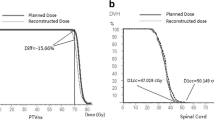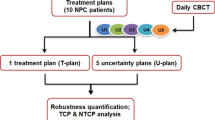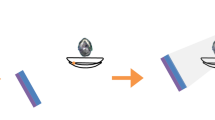Abstract
Computed tomography (CT) is the gold standard for radiotherapy simulation and treatment planning, providing spatial accuracy, bony anatomy definition and electron density information for dose calculations. Magnetic resonance imaging (MRI) has been introduced in radiotherapy to improve visualisation of anatomy for accurate target definition and contouring, however lacks electron density information required for dose calculations, with various methods used to overcome this. The aim of this work is to assess the impact on dose calculation accuracy and optimisation results of different approaches to determine electron density, as could be used in MRI only treatment planning for nasopharyngeal datasets with VMAT treatment plans. Volumetric modulated arc therapy (VMAT) plans were created for 10 retrospective head and neck (H&N) nasopharyngeal patients. The VMAT plans were generated on the gold standard dataset, the original CT scan. Data sets with no density correction (water equivalent) and two different sets of bulk density correction for bone/air/tissue applied separately were generated for these patients and the VMAT plans were recalculated for each case. Plans were also reoptimised on these data sets, and recalculated. Optimisation error was assessed through equivalent uniform dose (EUD) differences. Additionally, point dose comparison, dose volume histogram (DVH) analysis and gamma analysis of dose were used to assess dose calculation error. The dose calculation error on average was an increase in EUD whereas the optimisation error on average was a reduction in EUD compared to the original plan for all datasets aside from the bone only override dataset where bone was set to 1.61 g/cm3. For the optimisation error, the largest mean absolute error (MAE) was 1.88 Gy EUD for the PTV, and 2.21 Gy EUD for the brainstem, for the reoptimisation completed on the air only overridden dataset, and recalculated on the original. Bulk density corrections for bone and air provide dose calculations within 3% of the original treatment plans. Optimisation errors have the potential to be greater than dose calculation errors if incorrect density corrections are utilized. Electron density correction using a bulk density approach achieves dose calculation uncertainties within 3%, however more advanced approaches, such as a voxel based approach, may improve accuracy and should be considered.



Similar content being viewed by others
References
Nyholm T, Jonsson J (2014) Counterpoint: opportunities and challenges of a magnetic resonance imaging–only radiotherapy work flow. Semin Radi Oncol 24(3):175–180. https://doi.org/10.1016/j.semradonc.2014.02.005
Karlsson M, Karlsson MG, Nyholm T, Amies C, Zackrisson B (2009) Dedicated magnetic resonance imaging in the radiotherapy clinic. Int J Radiat Oncol*Biol*Phys 74(2):644–651. https://doi.org/10.1016/j.ijrobp.2009.01.065
Roberson PL, McLaughlin PW, Narayana V, Troyer S, Hixson GV, Kessler ML (2005) Use and uncertainties of mutual information for computed tomography/magnetic resonance (CT/MR) registration post permanent implant of the prostate. Med Phys 32(2):473–482. https://doi.org/10.1118/1.1851920 doi
Liney G, Owen S, Beaumont A, Lazar V, Manton D, Beavis A (2013) Commissioning of a new wide-bore MRI scanner for radiotherapy planning of head and neck cancer. Br J Radiol 86:20130150
Metcalfe P, Liney GP, Holloway L, Walker A, Barton M, Delaney GP, Vinod S, Tome W (2013) The potential for an enhanced role for MRI in radiation-therapy treatment planning. Technol Cancer Res Treat 12(5):429–446. https://doi.org/10.7785/tcrt.2012.500342
Raaymakers BW, Lagendijk JJ, Overweg J, Kok JG, Raaijmakers AJ, Kerkhof EM, Put RWvd, Meijsing I, Crijns SPM, Benedosso F, Vulpen Mv G, Allen J, Brown KJ (2009) Integrating a 1.5 T MRI scanner with a 6 MV accelerator: proof of concept. Phys Med Biol 54(12):N229
Fallone BG (2014) The rotating biplanar linac–magnetic resonance imaging system. Semin Radiat Oncol 24(3):200–202. https://doi.org/10.1016/j.semradonc.2014.02.011
Mutic S, Dempsey JF (2014) The ViewRay system: magnetic resonance–guided and controlled radiotherapy. Semin Radiat Oncol 24(3):196–199. https://doi.org/10.1016/j.semradonc.2014.02.008
Dowling JA, Lambert J, Parker J, Salvado O, Fripp J, Capp A, Wratten C, Denham JW, Greer PB (2012) An atlas-based electron density mapping method for magnetic resonance imaging (MRI)-alone treatment planning and adaptive MRI-based prostate radiation therapy. Int J Radiat Oncol*Biol*Phys 83(1):e5–e11. https://doi.org/10.1016/j.ijrobp.2011.11.056
Kapanen M, Collan J, Beule A, Seppälä T, Saarilahti K, Tenhunen M (2013) Commissioning of MRI-only based treatment planning procedure for external beam radiotherapy of prostate. Magn Reson Med 70(1):127–135
Korsholm M, Waring L, Edmund J (2014) A criterion for the reliable use of MRI-only radiotherapy. Radiat Oncol 9(1):16
Yu H, Caldwell C, Balogh J, Mah K (2014) Toward magnetic resonance–only simulation: segmentation of bone in MR for radiation therapy verification of the head. Int J Radiat Oncol*Biol*Phys 89(3):649–657
Dowling JA, Sun J, Pichler P, Rivest-Hénault D, Ghose S, Richardson H, Wratten C, Martin J, Arm J, Best L (2015) Automatic substitute computed tomography generation and contouring for magnetic resonance imaging (MRI)-Alone external beam radiation therapy from standard MRI sequences. Int J Radiat Oncol*Biol*Phys 93(5):1144–1153
Edmund JM, Nyholm T (2017) A review of substitute CT generation for MRI-only radiation therapy. Radiat Oncol 12(1):28
Guerreiro F, Burgos N, Dunlop A, Wong K, Petkar I, Nutting C, Harrington K, Bhide S, Newbold K, Dearnaley D (2017) Evaluation of a multi-atlas CT synthesis approach for MRI-only radiotherapy treatment planning. Physica Med 35:7–17
Lambert J, Greer PB, Menk F, Patterson J, Parker J, Dahl K, Gupta S, Capp A, Wratten C, Tang C, Kumar M, Dowling J, Hauville S, Hughes C, Fisher K, Lau P, Denham JW, Salvado O (2011) MRI-guided prostate radiation therapy planning: investigation of dosimetric accuracy of MRI-based dose planning. Radiother Oncol 98(3):330–334. https://doi.org/10.1016/j.radonc.2011.01.012
Lee YK, Bollet M, Charles-Edwards G, Flower MA, Leach MO, McNair H, Moore E, Rowbottom C, Webb S (2003) Radiotherapy treatment planning of prostate cancer using magnetic resonance imaging alone. Radiother Oncol 66(2):203–216. https://doi.org/10.1016/S0167-8140(02)00440-1
Chen L, Price R Jr, Nguyen T, Wang L, Li J, Qin L, Ding M, Palacio E, Ma C, Pollack A (2004) Dosimetric evaluation of MRI-based treatment planning for prostate cancer. Phys Med Biol 49(22):5157
Chen L, Price RA, Wang L, Li J, Qin L, McNeeley S, Ma C-MC, Freedman GM, Pollack A (2004) MRI-based treatment planning for radiotherapy: dosimetric verification for prostate IMRT. Int J Radiat Oncol*Biol*Phys 60(2):636–647
Karotki A, Mah K, Meijer G, Meltsner M (2011) Comparison of bulk electron density and voxel-based electron density treatment planning. J Appl Clin Med Phys 12(4):97–104
Whelan B, Kumar S, Dowling J, Begg J, Lambert J, Lim K, Vinod S, Greer P, Holloway L (2015) Utilising pseudo-CT data for dose calculation and plan optimization in adaptive radiotherapy. Australas Phys Eng Sci Med. https://doi.org/10.1007/s13246-015-0376-z
Jonsson J, Karlsson M, Karlsson M, Nyholm T (2010) Treatment planning using MRI data: an analysis of the dose calculation accuracy for different treatment regions. Radiat Oncol 5(1):62
Papanikolaou N, Battista JJ, Boyer AL, Kappas C, Klein E, Mackie TR, Sharpe M, Van Dyk J (2004) Tissue inhomogeneity corrections for megavoltage photon beams. AAPM Task Group 65:1–142
Chu JC, Ni B, Kriz R, Saxena VA (2000) Applications of simulator computed tomography number for photon dose calculations during radiotherapy treatment planning. Radiother Oncol 55(1):65–73
Cozzi L, Fogliata A, Buffa F, Bieri S (1998) Dosimetric impact of computed tomography calibration on a commercial treatment planning system for external radiation therapy. Radiother Oncol 48(3):335–338
White G, Wilson I (1992) Photon, electron, proton and neutron interaction data for body tissues. ICRU Report 46
Jonsson JH, Karlsson MG, Karlsson M, Nyholm T (2010) Treatment planning using MRI data: an analysis of the dose calculation accuracy for different treatment regions. Radiat Oncol 5:62–62. https://doi.org/10.1186/1748-717X-5-62
Constantinou C, Harrington JC, DeWerd LA (1992) An electron density calibration phantom for CT-based treatment planning computers. Med Phys 19(2):325–327
Gay HA, Niemierko A (2007) A free program for calculating EUD-based NTCP and TCP in external beam radiotherapy. Physica Med 23(3):115–125
Niemierko A (1997) Reporting and analyzing dose distributions: a concept of equivalent uniform dose. Med Phys 24(1):103–110
Stanescu T, Hans-Sonke J, Stavrev P, Fallone BG (2006) 3T MR-based treatment planning for radiotherapy of brain lesions. Radiol Oncol 40(2):125–132
Walker A, Liney G, Metcalfe P, Holloway L (2014) MRI distortion: considerations for MRI based radiotherapy treatment planning. Australas Phys Eng Sci Med 37(1):103–113. https://doi.org/10.1007/s13246-014-0252-2
Author information
Authors and Affiliations
Corresponding author
Ethics declarations
Conflict of interest
The authors declare no conflicts of interest.
Ethical approval
All procedures performed in studies involving human participants were in accordance with the ethical standards of the institutional and/or national research committee and with the 1964 Helsinki declaration and its later amendments or comparable ethical standards.
Rights and permissions
About this article
Cite this article
Young, T., Thwaites, D. & Holloway, L. Assessment of electron density effects on dose calculation and optimisation accuracy for nasopharynx, for MRI only treatment planning. Australas Phys Eng Sci Med 41, 811–820 (2018). https://doi.org/10.1007/s13246-018-0675-2
Received:
Accepted:
Published:
Issue Date:
DOI: https://doi.org/10.1007/s13246-018-0675-2




